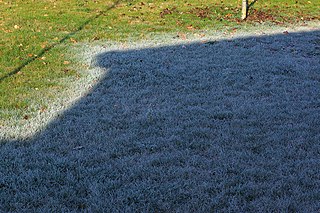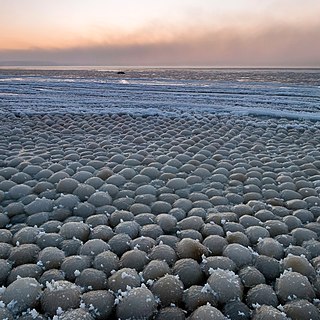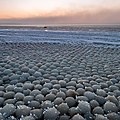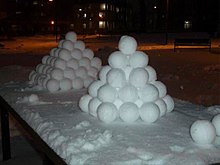
Frost is a thin layer of ice on a solid surface, which forms from water vapor that deposits onto a freezing surface. Frost forms when the air contains more water vapor than it can normally hold at a specific temperature. The process is similar to the formation of dew, except it occurs below the freezing point of water typically without crossing through a liquid state.

A glacier is a persistent body of dense ice that is constantly moving under its own weight. A glacier forms where the accumulation of snow exceeds its ablation over many years, often centuries. It acquires distinguishing features, such as crevasses and seracs, as it slowly flows and deforms under stresses induced by its weight. As it moves, it abrades rock and debris from its substrate to create landforms such as cirques, moraines, or fjords. Although a glacier may flow into a body of water, it forms only on land and is distinct from the much thinner sea ice and lake ice that form on the surface of bodies of water.

Ice is water that is frozen into a solid state, typically forming at or below temperatures of 0 °C, 32 °F, or 273.15 K. As a naturally occurring crystalline inorganic solid with an ordered structure, ice is considered to be a mineral. Depending on the presence of impurities such as particles of soil or bubbles of air, it can appear transparent or a more or less opaque bluish-white color.

Snow comprises individual ice crystals that grow while suspended in the atmosphere—usually within clouds—and then fall, accumulating on the ground where they undergo further changes. It consists of frozen crystalline water throughout its life cycle, starting when, under suitable conditions, the ice crystals form in the atmosphere, increase to millimeter size, precipitate and accumulate on surfaces, then metamorphose in place, and ultimately melt, slide or sublimate away.

The melting point of a substance is the temperature at which it changes state from solid to liquid. At the melting point the solid and liquid phase exist in equilibrium. The melting point of a substance depends on pressure and is usually specified at a standard pressure such as 1 atmosphere or 100 kPa.

Sintering or frittage is the process of compacting and forming a solid mass of material by pressure or heat without melting it to the point of liquefaction. Sintering happens as part of a manufacturing process used with metals, ceramics, plastics, and other materials. The nanoparticles in the sintered material diffuse across the boundaries of the particles, fusing the particles together and creating a solid piece.

Freezing is a phase transition where a liquid turns into a solid when its temperature is lowered below its freezing point. In accordance with the internationally established definition, freezing means the solidification phase change of a liquid or the liquid content of a substance, usually due to cooling.

Powder metallurgy (PM) is a term covering a wide range of ways in which materials or components are made from metal powders. PM processes can reduce or eliminate the need for subtractive processes in manufacturing, lowering material losses and reducing the cost of the final product.

Ski wax is a material applied to the bottom of snow runners, including skis, snowboards, and toboggans, to improve their coefficient of friction performance under varying snow conditions. The two main types of wax used on skis are glide waxes and grip waxes. They address kinetic friction—to be minimized with a glide wax—and static friction—to be achieved with a grip wax. Both types of wax are designed to be matched with the varying properties of snow, including crystal type and size, and moisture content of the snow surface, which vary with temperature and the temperature history of the snow. Glide wax is selected to minimize sliding friction for both alpine and cross-country skiing. Grip wax provides on-snow traction for cross-country skiers, as they stride forward using classic technique.

A snow roller is a rare meteorological phenomenon in which cylindrical snowballs are formed naturally as chunks of snow roll down hill or are blown along the ground by wind, picking up further snow along the way, in much the same way that the large snowballs used in snowmen are made. They can be as small as a tennis ball, but they can also be bigger than a car. Most snow rollers are a few inches or centimeters wide.

Regelation is the phenomenon of ice melting under pressure and refreezing when the pressure is reduced. This can be demonstrated by looping a fine wire around a block of ice, with a heavy weight attached to it. The pressure exerted on the ice slowly melts it locally, permitting the wire to pass through the entire block. The wire's track will refill as soon as pressure is relieved, so the ice block will remain intact even after wire passes completely through. This experiment is possible for ice at −10 °C or cooler, and while essentially valid, the details of the process by which the wire passes through the ice are complex. The phenomenon works best with high thermal conductivity materials such as copper, since latent heat of fusion from the top side needs to be transferred to the lower side to supply latent heat of melting. In short, the phenomenon in which ice converts to liquid due to applied pressure and then re-converts to ice once the pressure is removed is called regelation.
Titanium powder metallurgy (P/M) offers the possibility of creating net shape or near net shape parts without the material loss and cost associated with having to machine intricate components from wrought billet. Powders can be produced by the blended elemental technique or by pre-alloying and then consolidated by metal injection moulding, hot isostatic pressing, direct powder rolling or laser engineered net shaping.
The subnivean climate is the environment between fallen snow and terrain. This is the environment of many hibernal animals, as it provides insulation and protection from predators. The subnivean climate is formed by three different types of snow metamorphosis: destructive metamorphosis, which begins when snow falls; constructive metamorphosis, the movement of water vapor to the surface of the snowpack; and melt metamorphosis, the melting/sublimation of snow to water vapor and its refreezing in the snowpack. These three types of metamorphosis transform individual snowflakes into ice crystals and create spaces under the snow where small animals can move.
Rain and snow mixed or sleet is precipitation composed of a mixture of rain and partially melted snow. Unlike ice pellets, which are hard, and freezing rain, which is fluid until striking an object where it fully freezes, this precipitation is soft and translucent, but it contains some traces of ice crystals from partially fused snowflakes, also called slush. In any one location, it usually occurs briefly as a transition phase from rain to snow or vice-versa, but hits the surface before fully transforming. Its METAR code is RASN or SNRA.

A snowman is an anthropomorphic snow sculpture of a man often built in regions with sufficient snowfall and is a common winter tradition. In many places, typical snowmen consist of three large snowballs of different sizes with some additional accoutrements for facial and other features. Due to the sculptability of snow, there is also a wide variety of other styles. Common accessories include branches for arms and a smiley face made of stones, with a carrot used for a nose. Clothing, such as a hat or scarf, may be included.

Classifications of snow describe and categorize the attributes of snow-generating weather events, including the individual crystals both in the air and on the ground, and the deposited snow pack as it changes over time. Snow can be classified by describing the weather event that is producing it, the shape of its ice crystals or flakes, how it collects on the ground, and thereafter how it changes form and composition. Depending on the status of the snow in the air or on the ground, a different classification applies.
Yukimarimo are balls of fine frost formed at low temperatures on the Antarctic plateau during weak wind conditions. Yukimarimo were discovered in 1995 at Dome F by the 36th Japanese Antarctic Research Expedition (JARE-36) at temperatures of –59 to –72 °C. Electrostatic attraction between ice crystals explains the formation of yukimarimo at these low temperatures.

Snow science addresses how snow forms, its distribution, and processes affecting how snowpacks change over time. Scientists improve storm forecasting, study global snow cover and its effect on climate, glaciers, and water supplies around the world. The study includes physical properties of the material as it changes, bulk properties of in-place snow packs, and the aggregate properties of regions with snow cover. In doing so, they employ on-the-ground physical measurement techniques to establish ground truth and remote sensing techniques to develop understanding of snow-related processes over large areas.
Liquid phase sintering is a sintering technique that uses a liquid phase to accelerate the interparticle bonding of the solid phase. In addition to rapid initial particle rearrangement due to capillary forces, mass transport through liquid is generally orders of magnitude faster than through solid, enhancing the diffusional mechanisms that drive densification. The liquid phase can be obtained either through mixing different powders—melting one component or forming a eutectic—or by sintering at a temperature between the liquidus and solidus. Additionally, since the softer phase is generally the first to melt, the resulting microstructure typically consists of hard particles in a ductile matrix, increasing the toughness of an otherwise brittle component. However, liquid phase sintering is inherently less predictable than solid phase sintering due to the complexity added by the presence of additional phases and rapid solidification rates. Activated sintering is the solid-state analog to the process of liquid phase sintering.

Ice eggs, or ice balls, are a rare phenomenon caused by a process in which small pieces of sea ice in open water are rolled over by wind and currents in freezing conditions and grow into spheroid pieces of ice. They may collect into heaps of balls or 'eggs' on beaches where they pack together in striking patterns.






















